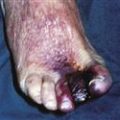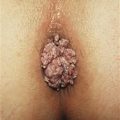Nasal Discharge
Nasal discharges are common. The most frequent causes are the common cold and allergic rhinitis. Persistent bloodstained nasal discharge is a serious symptom requiring urgent investigation.
History
Congenital
Choanal atresia is rare. Check for other congenital abnormalities. Bilateral choanal atresia is a life-threatening condition in newborn infants. Unilateral atresia may not be picked up until 5–10 years of age, when it becomes apparent that one nostril is blocked and there is a thick mucus discharge.
Acquired
Infective
The patient will often have a common cold. There is a mucoid nasal discharge, which settles rapidly once the cold has settled. With chronic rhinitis, there may be a chronic purulent discharge. This is often thick and mucoid. There may be a history of immunological deficiency or cystic fibrosis. With sinusitis, there may be pain or discomfort over the maxillary sinuses or a headache with pain over the frontal sinuses. With large adenoids, there may be a complaint of mouth breathing, recurrent pharyngeal infections, snoring and recurrent ear infections. Fungal infections of the nose are rare, occurring in immunosuppressed patients. Candida albicans and Aspergillus spp. are the most common organisms. Chronic infective lesions include syphilis. Secondary syphilis can affect the nose and cause a catarrhal rhinitis. Usually, other lesions of syphilis will be present. AIDS may be associated with a watery nasal discharge. Check for HIV risk factors. Other symptoms of AIDS may be present.
Allergic
Allergic rhinitis
There may be a history of infantile eczema, allergic asthma, nasal or conjunctival allergy. It may be seasonal with an allergy to pollen or perennial with exposure to animal dander (cats) or house-dust mites. The patient complains of watery rhinorrhoea, sneezing attacks, nasal obstruction, conjunctival irritation and lacrimation. There is usually a family history.
Inflammatory
Vasomotor rhinitis
Eosinophilic vasomotor rhinitis presents with a watery nasal discharge and sneezing. No type I allergic reaction is involved in this condition. The condition is associated with nasal polyps, aspirin sensitivity and asthma.
Nasal polyps
These occur in non-allergic eosinophilic vasomotor rhinitis. The patient will complain of nasal obstruction and discharge.
Non-eosinophilic vasomotor rhinitis
The patient presents with watery nasal discharge, nasal obstruction and sneezing attacks. This condition may be associated with: (1) certain antihypertensive drugs, particularly ganglion blockers and vasodilators; (2) hormonal disturbances; (3) congestive cardiac failure; (4) anxiety states; (5) occupational irritants, e.g. ammonia, smoke.
Neoplastic
Nasopharyngeal carcinoma
Nasopharyngeal carcinoma is rare in Europe but is common in South-east Asia. The patient presents with nasal obstruction and bloodstained discharge. Unilateral otitis media may occur from eustachian tube blockage. Nerve palsies may occur due to invasion of the base of the skull. The patient may complain only of a swelling in the neck due to lymphadenopathy; lymphatic spread occurring at an early stage. With this disease, unilateral deafness, cervical lymphadenopathy and cranial nerve palsies are often diagnostic.
Carcinoma of the maxillary sinus
This is often diagnosed late. Early presenting symptoms include bloodstained nasal discharge and unilateral nasal obstruction. Later, swelling of the cheek occurs, with ulceration of the palate. Epiphora may occur due to invasion of the nasolacrimal duct. Erosion into the orbit results in proptosis and diplopia. Pain may be referred to the ear.
Malignant granuloma
Malignant granuloma (now thought to be lymphomatous) presents with slowly progressive ulceration, starting in the region of the nose. The chronic inflammatory reaction causes a nasal discharge.
Granulomatous disease
Wegener’s granulomatosis and Churg–Strauss syndrome affect the nose and are associated with disease of the kidneys, lungs and respiratory tract. The patient may present with either lung manifestations or renal failure.
Traumatic
The commonest trauma causing a nasal discharge is a foreign body. The patient is usually a child aged between 1 and 5 years, or rarely, a psychiatrically-disturbed adult. The child is usually miserable with a smelly, bloodstained nasal discharge. In adults, rhinolith may occur. This results in unilateral obstruction and discharge. There is usually a large concretion blocking the nose, which may have a foreign body at the centre, with calcium and magnesium laid down around it. Following fracture of the anterior fossa, sustained during head injury, the patient may complain of a clear nasal discharge (CSF rhinorrhoea) or a bloodstained nasal discharge. Irritant gases, e.g. chlorine, which may be industrial or in excess in swimming pools, may cause irritation of the nasal mucosa, with discharge.
Degenerative
Senile rhinorrhoea occurs in the elderly. It is thought to be due to failure of vasomotor control.
Examination
Choanal atresia
Pass a probe or catheter into the nasal cavity. It will not pass. Posterior rhinoscopy under general anaesthetic will confirm the diagnosis.
Infective
With a common cold, there will be oedematous nasal mucosa with clear mucus in the nose. With chronic rhinitis, there will be thick mucus or a purulent nasal discharge. With enlarged adenoids, mirror examination will reveal the diagnosis.
Allergic
Allergic rhinitis reveals an oedematous nasal mucosa with clear mucus in the nose.
Inflammatory
The appearance of eosinophilic vasomotor rhinitis is similar to that of allergic rhinitis, except that nasal polyps may be seen. Nasal polyps are usually pink and smooth or a yellowish-grey and pedunculated. With non-eosinophilic vasomotor rhinitis, excessive secretions will be noted on examination, with engorgement of the inferior turbinates. Often the signs are not as severe as the symptoms would suggest.
Neoplastic
Examination should include visualisation of the post-nasal space, under general anaesthetic if necessary. A full examination of the cranial nerves must be made. With carcinoma of the maxillary sinus, there may be swelling of the cheek with ulceration of the palate. Epiphora may occur due to invasion of the nasolacrimal duct. Check for proptosis and diplopia due to invasion into the orbit. Examine the neck for cervical nodes. With malignant granuloma, there is slowly progressive ulceration of the face, starting in the region of the nose.
Granulomatous disease
With Wegener’s granulomatosis or Churg–Strauss syndrome, necrotic mucosal ulceration occurs. There may be co-existing otitis media, ulceration of the mouth or involvement of the trachea or larynx. There may be lung involvement, eye involvement and renal disease.
Traumatic
Examination with a nasal speculum will usually reveal the foreign body. With CSF rhinorrhoea, it may be difficult to distinguish bleeding from blood mixed with CSF. Place a drop of the bloodstained discharge on a clean white gauze. If CSF is present, there will be a spreading yellowish ring around the central stain of blood (halo sign). With irritant gases, there will be redness and oedema of the nasal mucosa. There will almost certainly be eye irritation and a skin reaction accompanying it.
Degenerative
With senile rhinorrhoea, there are usually no physical signs apart from the nasal drip.
General Investigations
■ FBC, ESR and CRP
Hb ↓ malignancy, granulomatous disease. WCC ↑ infection, e.g. adenoiditis. ESR and CRP ↑ infection, malignancy, granulomatous disease.
■ Swab
Culture and sensitivity. Bacterial versus fungal.
■ Skull X-ray
Anterior cranial fossa fracture involving ethmoid bone – CSF rhinorrhoea. Carcinoma of the maxillary antrum.




